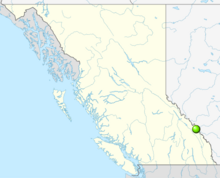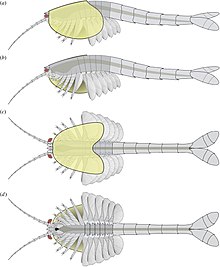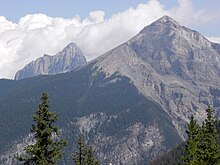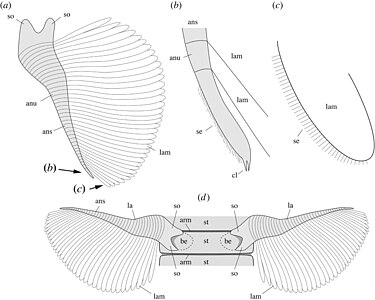Waptia
| Waptia Temporal range:
| |
|---|---|

| |
| Fossil specimens of Waptia | |

| |
| Artist's reconstruction of Waptia fieldensis | |
| Scientific classification | |
| Domain: | Eukaryota |
| Kingdom: | Animalia |
| Phylum: | Arthropoda |
| Clade: | Mandibulata |
| Order: | †Hymenocarina |
| Genus: | †Waptia Walcott, 1912 |
| Species: | †W. fieldensis
|
| Binomial name | |
| †Waptia fieldensis Walcott, 1912
| |

| |
| Location of the Burgess Shale Formation in British Columbia | |
| Synonyms | |
| |
Waptia is an
Based on the number of individuals, Waptia fieldensis is the third most abundant arthropod from the Burgess Shale Formation, with thousands of specimens collected. It was among the first
Although it bears a remarkable resemblance to modern crustaceans, its taxonomic affinities were long unclear. A comprehensive redescription published in 2018 classified it a member of Hymenocarina (which contains numerous other bivalved arthropods) within Mandibulata.
Description

Known specimens of Waptia range in length from 13.5 to 66.5 millimetres (0.53 to 2.62 in) with the vast majority (~85%) being 40 to 60 millimetres (1.6 to 2.4 in) long. The bivalved carapace was saddle shaped, and was thin and non mineralised, and was likely flexible in life. The carapace was laterally compressed, and had no distinct boundary between the two halves. The carapace was only attached to the body in a small section near the front of the head. The body was divided into three main segments, the cephalothorax (head), the post-cephalothorax, and the abdomen.
The front of the head bore a pair of reniform (kidney shaped) eyes, about 1 millimetre (0.039 in) across, which were born on short stalks. One specimen with preserved
The
The "post-cephalothorax" has 5 segments, associated with 6 somites with corresponding pairs of uniramous annulated appendages, which are fringed with lamellae. The following abdomen is approximately 60% of the total length, with 6 segments and no corresponding legs, which terminates in a forked tail fluke, in which each fluke is composed of three segments.[1]
-
Diagram of the mandibles (light grey) and maxillae (dark grey) of Waptia in side-on (top) and from below (bottom) with the two versions showing movement range of the appendages.
-
Morphology of the cephalothoracic appendages in side-on view (top) and from the front
-
Post-cephalothorax appendages in side on view (a) with close-up of the tip of the appendage (b) and closeup of the lamellae (c), and a view from below of a sternite with attached appendages
Discovery


Waptia fieldensis was one of the first fossils discovered by
Taphonomy
Specimens of Waptia fieldensis were recovered from the
Based on the number of individuals, Waptia fieldensis constitutes about 2.55% of the total number of organisms recovered from the Burgess Shale, and 0.86% of the
Specimens of Waptia, referred to as Waptia cf. fieldensis have also found recovered from the Middle Cambrian Spence Shale in Utah, USA.[5][11][12] Some of these specimens are associated with three dimensionally preserved eggs.[13]
Taxonomy
Waptia fieldensis is the only
Some authors suggested that Waptia may be allied to

In 1975, an apparently very similar species was described from the
In 2002, a second similar species,
Ecology
While historically considered
In 2015, egg clutches were identified in six specimens from the Burgess Shale. The clutch sizes were small, only containing up to 24 eggs, but each egg was relatively large, with an average diameter of 2 mm (0.079 in). They were attached along the inner surface of the bivalved carapace. Along with
See also
References
- ^ PMID 30110460.
- ^ Smithsonian Institution Archives, Accession 10-166, Walcott, Charles D, (Charles Doolittle), 1850-1927, Charles D. Walcott Collection
- ^ ISBN 1-56098-364-7.
- ^ ISBN 9780393027051.
- ^ a b c d e "Waptia fieldensis". Royal Ontario Museum. 2011. Retrieved January 14, 2012.
- ^ Charles D. Walcott (1912). "Cambrian geology and paleontology II: Middle Cambrian Branchiopoda, Malacostraca, Trilobita, and Merostomata". Smithsonian Miscellaneous Collections. 57 (6): 453–456.
- ^ a b Simon Conway Morris (1986). "The community structure of the Middle Cambrian Phyllopod Bed (Burgess Shale)". Palaeontology. 29 (Part 3): 423–467.
- ISBN 978-0-231-10254-4.
- ^ S2CID 53646959.
- ^ .
- ^ "Waptia cf. fieldensis Walcott, 1912". Division of Invertebrate Paleontology, University of Kansas. October 4, 2007. Retrieved January 14, 2012.
- S2CID 31568651.
- S2CID 239239374.
- ^ Mikko Haaramo (October 4, 2007). "Crustaceomorpha – crustaceans and related arthropods". Mikko's Phylogeny Archive. Retrieved January 14, 2012.
- ^ Hu-Qin Liu & De-Gan Shu (2004). "New information on Chuandianella from the Lower Cambrian Chengjiang Fauna, Yunnan, China" [澄江化石库中川滇虫属化石的新信息]. Journal of Northwest University (Natural Science Edition) (in Chinese). 34 (4): 453–456.
- S2CID 247123967.
- S2CID 13074384.
- PMID 26711492.
- .
- ^ Emily Chung (18 December 2015). "Burgess Shale fossil Waptia may be oldest mom ever found caring for eggs". CBC News. Retrieved 24 May 2016.
- PMID 32426476.
External links
- "Waptia fieldensis". Burgess Shale Fossil Gallery. Virtual Museum of Canada. 2011. Archived from the original on 2020-11-12.
- "Waptia fieldensis". Smithsonian National Museum of Natural History. 2012.




